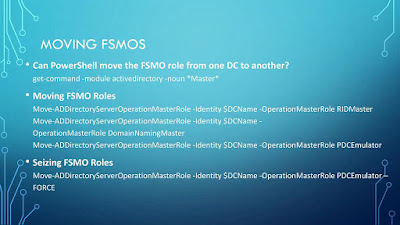Powershell: Move (Transfering or Seizing) FSMO Roles to Another Domain Controller
Advantages
Moving the FSMO roles with the AD PowerShell has the following advantages:
- It must not first connect to the future Domain Controller role holders.
- Only Seizing (role holder is offline) the FSMO roles will require an additional parameter, you must use -Force parameter.
- Transfering or Seizing the FSMO roles must not necessarily be done from the role holder or the future role holder. You can run the AD-Powershell command from a Windows 7 Client or Windows Server 2008 R2 member server (after RSAT is installed).
Transfering all roles
Move-ADDirectoryServerOperationMasterRole -Identity "Target-DC" -OperationMasterRole 0,1,2,3,4
Seizing all roles
Move-ADDirectoryServerOperationMasterRole -Identity "Target-DC" -OperationMasterRole 0,1,2,3,4 -Force
| Role Name | Number |
| PDCEmulator | 0 |
| RIDMaster | 1 |
| InfrastructureMaster | 2 |
| SchemaMaster | 3 |
| DomainNamingMaster | 4 |
Transfering all roles
Move-ADDirectoryServerOperationMasterRole -Identity "Target-DC" -OperationMasterRole SchemaMaster,RIDMaster,InfrastructureMaster,DomainNamingMaster,PDCEmulatorSeizing all roles
Move-ADDirectoryServerOperationMasterRole -Identity "Target-DC" -OperationMasterRole SchemaMaster,RIDMaster,InfrastructureMaster,DomainNamingMaster,PDCEmulator






No comments:
Write comments